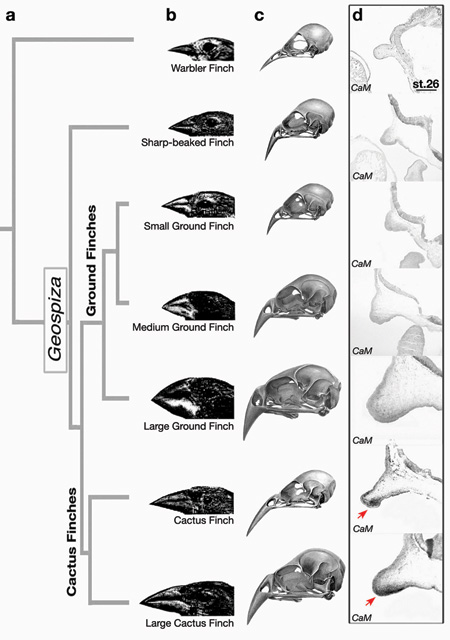How Darwin’s finches got their beaks
A gene’s-eye view of evolution
Darwin’s finches are the emblems of evolution. The birds he saw on the Galapagos Islands during his famous voyage around the world in 1831-1836 changed his thinking about the origin of new species and, eventually, that of the world’s biologists.
Darwin wondered about the changes in shape of bird beaks from island to island. So-called cactus finches boast longer, more pointed beaks than their relatives the ground finches. Beaks of warbler finches are thinner and more pointed than both. These adaptations make them more fit to survive on available food.
Researchers at Harvard Medical School have taken the story one step further. Using modern genetic analyses, they found a molecule that regulates genes involved in shaping the beaks of Darwin finches. “Calmodulin is a protein that binds and activates certain enzymes, which triggers a signal that eventually turns specific genes on or off,” explains Arkhat Abzhanov, an evolutionary biologist at Harvard. These signals alter the behavior of cells responsible for beak sculpturing.
Members of the research team received permission to collect finch eggs from the Galapagos National Park, a group of rocky islands in the Pacific Ocean, about 600 miles west of Ecuador. Female finches lay clutches of four to five eggs, one per day. To avoid disruption and abandonment of the nests, the researchers took only the third eggs laid.
In the Department of Genetics at Harvard Medical School, 26 bird embryos were examined, using gene chips that reveal which genes are most active in the heads of the developing finches. This activity was then matched with the size and shapes of adult beaks.
The investigation soon focused on calmodulin as the switch that can turn on genes involved in increasing beak length. This protein had never before been implicated in the development of the skulls and faces of any birds.
“We found that calmodulin was indeed expressed at detectably higher levels in cactus finches compared to ground finches, and thus associated with their longer beaks,” says Clifford Tabin, professor of genetics. “This higher level is both biologically relevant and functionally important for shaping of elongated beaks, which are used in a specialized manner to probe cactus flowers and fruit for pollen, nectar, and seeds.” The same surge of calmodulin was not found in more blunt-beaked ground finches.
A beak at evolution
When Charles Darwin first saw the Galapagos Islands he described them as 10 islands “situated under the equator.” He noted that they originated as volcanoes and were pockmarked with craters. “Some of the craters, surmounting the larger islands, are of immense size, and they rise to a height of between three and four thousand feet.”
Noting differences in the feeding habits of the finches, Darwin wrote that cactus finches “may often be seen climbing about the flowers of the great cactus trees.” Seeing the diversity of beaks and other structures in the closely related finches, he wrote in his notebook, “one might really fancy that one species had been taken and modified for different ends.”
Darwin elaborated on this idea when he published his intellectual bombshell, the “Origin of Species,” some 25 years later in 1859. He speculated that birds, resembling starlings, came to the Galapagos Islands by wind. Evolution took over and different groups developed different diets. When, he wrote, “an immigrant first settled on one of the islands, … it would undoubtedly be exposed to different conditions in the different islands (where) it would have to compete with a different set of organisms. … Then, natural selection would probably favor different varieties in the different islands.”
In other words, beaks changed as the birds developed different tastes for fruits, seeds, or insects picked from the ground or cacti. Long, pointed beaks made some of them more fit for picking seeds out of cactus fruits. Shorter, stouter beaks served best for eating seeds found on the ground. Eventually, the immigrants evolved into 14 separate species, each with its own song, food preferences, and beak shapes. Warbler finches, for example, catch insects in beaks that are sharper and more slender than those of cactus eaters.
For the future, Abzhanov notes, “there remain seven or eight other unique-beaked Darwin finches to explore. These birds serve as an ideal starting point [for studying the role of calmodulin], because they are very closely related yet very diverse in shape and structure.
“We also expect calmodulin to be important in other groups of long-beaked birds. However, this is not going to be the whole story for birds such as storks and ibises. Increasing calmodulin activity leads to a modest 10-14 percent increase in beak length, which matches well with the length differences between cactus and ground finches but additional mechanisms might be required for even longer beaks.”
Abzhanov, Tabin, and their colleagues at Harvard, Princeton, and the Institute of Molecular Pathology in Vienna, Austria, published the result of their finch research in the Aug. 3 issue of the journal Nature.
Asked about the possibility of calmodulin in the heads of humans, Abzhanov answers, “At this point we don’t know whether mammals in general or humans in particular employ calmodulin during development of their skulls and faces. It is, however, very likely as calmodulin appears to be involved in very basic craniofacial developmental processes. We do know it is expressed at the right time and in the right place in the development of mice embryos. We will certainly pursue its role(s) during both mouse and chicken development.”





